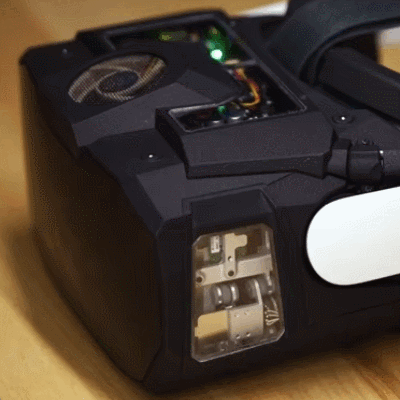See Some Of The Stranger VR Ideas From SIGGRAPH [Hackaday]

[Devin Coldewey] shared his experiences with some of the more unusual VR concepts on display at SIGGRAPH 2023. Some of these ideas are pretty interesting in their own right, and even if they aren’t going to actually become commercial products they give some insight into the kinds of problems that are being worked on. Read on to see if anything sparks ideas of your own.
In the area of haptics and physical feedback, Sony shared research prototypes that look like short batons in which are hidden movable weights. These weights can shift up or down on demand, altering their center of gravity. [Devin] states that these units had a mild effect on their own, but when combined with VR visuals the result was impressive. There’s a video demonstration of how they work.
A more unusual take on physical feedback was a wrist-mounted device with two flywheels attached to it. This device — dubbed SomatoShift — is shown in the header image above. They work exactly like the reaction wheels on satellites. By turning these spinning wheels, different forces can be felt by the wearer. The prototype looks cumbersome, but the forces exerted by the system can be controlled with very high accuracy.
JumpMod is something readers may remember from earlier this year, and consists of a 2 kg weight worn as a backpack. By moving the weight upward or downward at precise times, the wearer can feel the illusion of a higher (or lower) than normal jump.

VR headset research prototypes from Meta made an appearance, including a light field passthrough headset (Flamera prototype) that has a fascinating external lens array and a varifocal display (named Butterscotch) which may remind regular readers of prototypes showcased last year.
Let us take a moment to bring up some other experimental work that, while not present at SIGGRAPH, is nevertheless good idea fodder. Finger Haptics uses electrical signals to simulate feeling in the palm side of the hand and fingers, which is notable because the hand is left free to hold and manipulate objects normally. Nothing is actually worn or mounted on the palm-side of the hands or fingers.
Another approach is from the company Tactical Haptics which created a grip with sliding panels that simulate feelings of feedback via a shearing kind of movement (PDF) which seems like an approach particularly suited to some DIY.
Finally, one of our favorite DIY projects is Real Virtual Magic, which uses a small off-the-shelf EEG unit to make magic’s effectiveness in Skyrim VR depend on the wearer’s actual state of mind.
Know of any other interesting, useful, or just plain bizarre VR interface ideas? Share them in the comments, or use the tips line. We’d love to hear about them.

![see-some-of-the-stranger-vr-ideas-from-siggraph-[hackaday]](https://i0.wp.com/upmytech.com/wp-content/uploads/2023/09/140703-see-some-of-the-stranger-vr-ideas-from-siggraph-hackaday.png?resize=800%2C445&ssl=1)